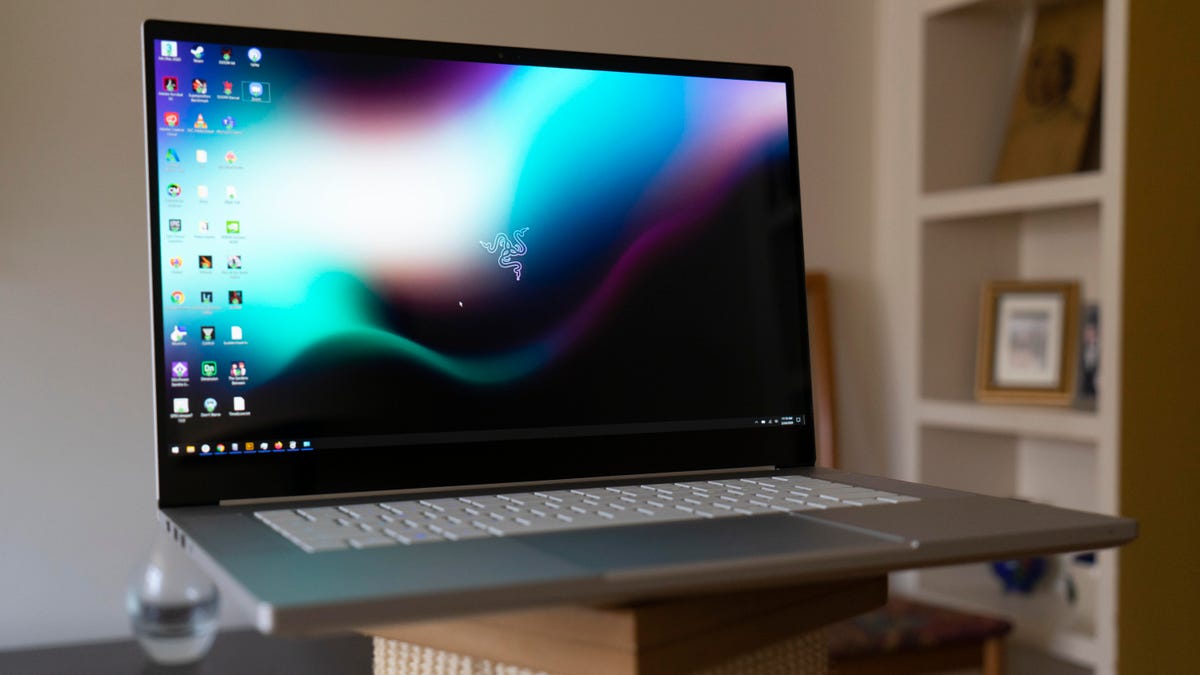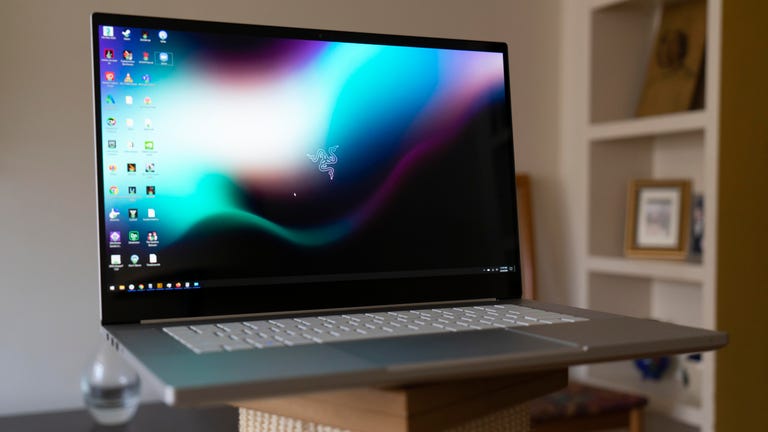 Why You Can Trust CNET
Why You Can Trust CNET Razer Blade Studio Edition review: A pricey MacBook Pro alternative for graphics pros
It's not the fastest in its class, but with workstation-level graphics, an OLED display and a sleek design, the Studio Edition delivers a great balance.

You're probably not in the mood to think about a $4,000 (£4,000 or about AU$7,900) laptop right now, but if you're attempting to edit video, work with 3D models or perform other pro-level graphics tasks at home, now's the time to start considering one. And if you're going to go for it, Razer 's sleek Blade 15 Studio Edition delivers a balanced combination of design, speed and features for folks who need workstation-class graphics and Windows. It'll serve you well when you can finally head back to the office, too.
Like
- Slim, attractive design
- Easy-on-the-eyes OLED screen
Don't like
- Expensive
- OLED is suboptimal for some professional uses
If you're only editing photos, however, this may not be right for you. Why not? Because its expensive Nvidia Quadro RTX 5000 graphics card, which differentiates it from a Razer Blade 15 Advanced , may not be worth paying for. A lot of photo work demands more processing power, and you might be better off opting for a system with a more high-powered processor instead.
Because of the design, the Razer Blades inevitably get compared to Apple MacBook Pros. And while I love the rainbow illumination on the keyboard and the high-contrast OLED display on the Razer, it can't match the MacBook Pro 16 for performance and battery life at about the same price.
The Studio Edition is essentially the top-end Blade 15 Advanced OLED -- in Mercury White! -- with a few differences. The Quadro RTX 5000 graphics is the biggest step up from the more common GeForce RTX 2080. In terms of specs, the RTX 5000 is roughly equivalent to the 2080 Super, a GPU still only available in desktop graphics cards.
Razer Blade 15 Studio Edition
| Price as reviewed | $4,000 or £4,000, converts to about AU$7,400 |
|---|---|
| Display size/resolution | 15.6-inch 3,840x2,160-pixel OLED touchscreen 60Hz |
| PC CPU | Intel Core i7-9750H |
| PC Memory | 32GB 2,666Hz DDR4 |
| Graphics | Nvidia Quadro RTX 5000 |
| Storage | 1TB SSD, SD card slot |
| Ports | 1x USB-C/Thunderbolt 3, 3x USB-A 3.1, 1x HDMI 2.0, 1x mini DisplayPort, 1x audio |
| Networking | Wi-Fi 6 (802.11ax), Bluetooth 5.0 |
| Operating system | Microsoft Windows Pro (64-bit) |
| Weight | 4.9 pounds (2.2 kilograms) |
Unless you're looking for software certification or support for more graphics memory, stability or 16GB of GPU RAM compared to the 2080's 8GB, you may want to stick with the less expensive lower-end configuration. Unfortunately, if you do that you also get less memory and storage: The Studio model comes with 32GB RAM and 1TB SSD versus 16GB and 512GB.
The Studio model also has an SD card slot, which really comes in handy.
About two months subsequent to this review's original publication, Razer refreshed the Studio with a Core i7-10875H processor, which bumps it to eight cores from six -- and increased the price to $4,299. (Only in the US; the UK model is still the same as we tested.) Its performance relative to other systems with the same processor should remain about the same, though the newer processor will definitely give it a speed boost over the 9750H and likely a bit better battery life. Also of note, the newer model incorporates the Intel AX201 Wi-Fi 6 chipset, which seems to have fewer issues when connected to a Wi-Fi 5 (802.11ac) access point than the AX200 did.
Our test configuration didn't run as hot as the original Advanced, but it also seemed throttled at times even at max cooling settings with the fans blowing loudly. Nor did it consistently sustain CPU frequency when running full tilt and doesn't often get past 4GHz, much less the the maximum 4.6GHz its Intel Core i7-9750H is capable of, even on a single core. On benchmarks, it sits in the middle of the pack on CPU performance relative to comparable systems.
The refresh also fixed one of my main complaints about the keyboard, the too-small right shift key, which resulted in hitting the up arrow instead. Overall, though, the built-in keyboard feels pretty good for typing, if a bit shallow, but I still think that if you're considering it for typing-intensive tasks like game programming you may want an external keyboard. And the power cord is stiff and unmaneuverable with an oversized connector.
A full set of connections -- including HDMI and mini DisplayPort -- plus an SD card slot make it a flexible option for creatives.
Its graphics performance isn't quite as good as we see from the same GPU in the 17-inch HP ZBook 17. But with more airflow space to work with, a higher power draw, and Xeon processor, that's not a surprise. The 17-inch Acer Predator Helios 700 also performs better on some typical workstation tasks despite its GeForce graphics. You'll get better frame rates in applications such as Autodesk 3ds Max and Maya (as measured by SpecViewPerf 13), in part thanks to a more powerful desktop-class unlocked i9-9900K processor. But the RTX 5000 seems notably faster than the RTX 3000, so it's probably worth the extra bucks if you need it.
It can certainly handle 4K, and even 5K video editing, pretty well. It's no slouch for gaming , either. The 4K OLED display looks purdy, and as high-contrast as you'd expect from OLED. But for accuracy it's about the same as most of the laptop implementations of the panel I've seen, with a single Windows color profile from factory calibration. It's suboptimal for working in Adobe RGB because its P3 gamut is missing range in cyans and it overdoes saturated colors. It does support HDR video and games.
And while it doesn't have the best battery life at about six hours as tested, that's still longer than most power laptops .
You won't find class-leading performance here, but it's a winning combination of power, features and design, especially if you need the workstation graphics under Windows. It still can't quite outdo the top-end MacBook Pro 16, unless you really need to be on Windows or have a yen for the OLED touchscreen.
Geekbench 5 (multicore)
Cinebench R20 CPU (multicore)
Video playback battery drain test (Streaming)
Geekbench 5 (Vulkan)
3DMark Fire Strike Ultra
3DMark Port Royal (RTX)
System configurations
| Acer ConceptD 5 | Microsoft Windows 10 Home (64-bit); 2.6GHz Intel Core i7-9750H; 32GB DDR4 SDRAM 2,666MHz; 6GB Nvidia Quadro RTX 3000; 3TB RAID 0 HDD |
|---|---|
| Apple MacBook Pro 16 | Apple macOS Catalina 10.15.1; 2.4GHz Intel Core i9-9980HK; 32GB DDR3 SDRAM 2,666MHz; 8GB Radeon Pro 5500M/1,536MB Intel HD Graphics 630; 2TB SSD |
| HP ZBook 17 G6 | Microsoft Windows 10 Pro for Workstations (1903); 2.4GHz Intel Xeon E-2286M; 64GB DDR4 SDRAM 2,666MHz; 16GB Nvidia Quadro RTX 5000 with Max-Q Design; 1TB SSD |
| Maingear Element | Microsoft WIndows 10 Pro (1903); 2.6GHz Intel Core i7-9750H; 32GB DDR4 SDRAM 2,667MHz, 8GB Nvidia GeForce RTX 2070 with Max-Q Design, 2TB SSD |
| Razer Blade 15 Studio Editon | Microsoft Windows 10 Pro (1909); 2.6GHz Intel Core i7-9750H; 32GB DDR4 SDRAM 2,666MHz; 16GB Nvidia Quadro RTX 5000 with Max-Q Design; 1TB SSD |
| Razer Blade Advanced (2019, OLED) | Microsoft Windows 10 Home (64-bit); 2.6GHz Intel Core i7-9750H; 16GB DDR4 SDRAM 2,666MHz; 8GB Nvidia GeForce RTX 2080 with Max-Q Design; 512GB SSD |
First published on March 25.


